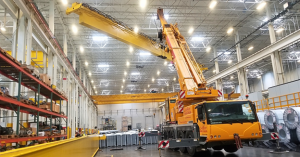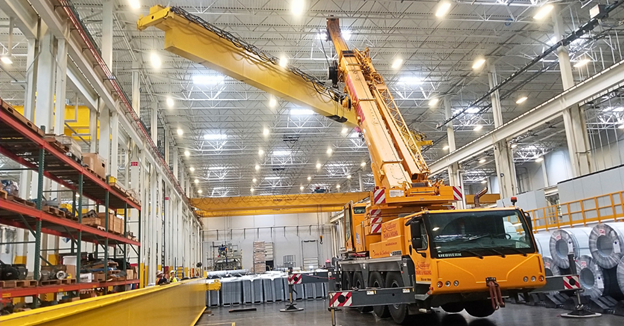Overhead cranes are indispensable assets in numerous industries, facilitating the efficient and safe movement of heavy loads. However, unexpected overhead crane breakdowns can lead to significant downtime, financial losses, and potential safety hazards.

This article delves into the top five most common causes of an overhead crane breakdown and provides comprehensive strategies for prevention, ensuring optimal performance and longevity.
Understanding the Impact of an Overhead Crane Breakdown
Before exploring the causes and prevention strategies, it’s essential to recognize the far-reaching consequences of an overhead crane breakdown. These include:
- Production Downtime – Lost production time translates directly to revenue losses and missed deadlines.
- Safety Hazards – Malfunctioning cranes pose significant safety risks to personnel and equipment.
- Increased Maintenance Costs – Emergency repairs and component replacements are often more expensive than preventive maintenance.
- Operational Inefficiencies – Unreliable cranes disrupt workflow and reduce overall operational efficiency.
- Damage to Materials – An uncontrolled load can damage product, or the work area.
Most Common Causes of an Overhead Crane Breakdown
#1. Electrical System Failures
Cause: Electrical system failures are a leading cause of overhead crane breakdowns, often stemming from loose connections, damaged wiring, faulty contactors, or malfunctioning control systems.
Prevention:
-
- Regular Inspections – Conduct thorough inspections of electrical panels, wiring, and control systems, checking for loose connections, corrosion, and damage.
- Preventive Maintenance – Implement a preventive maintenance schedule that includes cleaning and tightening electrical connections, replacing worn contactors, and testing control systems.
- Surge Protection – Install surge protectors to protect electrical components from voltage spikes and power fluctuations.
- Qualified Personnel – Ensure that all electrical work is performed by qualified and certified electricians.
- VFD Maintenance – Variable frequency drives, or VFDs, should have regular inspections, and filter replacement.
#2. Mechanical Component Wear and Tear
Cause: Mechanical components, such as gears, bearings, wheels, and brakes, are subject to wear and tear over time, leading to premature failure causing overhead crane breakdowns.
Prevention:
-
- Lubrication – Implement a rigorous lubrication program, using the appropriate lubricants for each component and adhering to recommended lubrication intervals.
- Regular Inspections – Conduct regular inspections of mechanical components, checking for wear, damage, and misalignment.
- Component Replacement – Replace worn or damaged components promptly, following manufacturer’s specifications.
- Alignment Checks – Regularly check runway rail alignment, and crane wheel alignment, to prevent premature wear.
- Brake Adjustments – Regularly check, and adjust brake systems.
#3. Hoist System Malfunctions
Cause: Hoist system malfunctions, including wire rope damage, drum issues, and motor failures, can lead to critical breakdowns
Prevention:
-
- Wire Rope Inspections – Conduct frequent inspections of wire ropes, checking for wear, fraying, and damage.
- Drum Maintenance – Regularly inspect and maintain hoist drums, ensuring proper alignment and lubrication.
- Motor Inspections – Inspect hoist motors for signs of overheating, vibration, and unusual noises.
- Limit Switch Checks – Regularly check, and test all limit switches.
- Proper Reeving – Ensure that the wire rope is reeved correctly.
#4. Overloading and Misuse
Cause: Overloading the crane beyond its rated capacity or misusing it for unintended purposes can cause severe damage and an overhead crane breakdown.
Prevention:
-
- Operator Training – Provide comprehensive operator training on proper crane operation, load capacity, and safety procedures.
- Load Monitoring – Implement load monitoring systems to prevent overloading.
- Clear Operating Procedures – Develop and enforce clear operating procedures that prohibit misuse and overloading.
- Warning Systems – Install overload warning systems.
- Regular Refresher Training – Provide regular refresher training for all crane operators.
#5. Environmental Factors:
Cause: Harsh environmental conditions, such as extreme temperatures, humidity, dust, and corrosive substances, can accelerate component wear and corrosion, leading to breakdowns.
Prevention:
-
- Environmental Protection – Implement environmental protection measures, such as protective coatings, enclosures, and filtration systems, to mitigate the effects of harsh conditions.
- Material Selection – Select materials and components that are resistant to the specific environmental conditions.
- Regular Cleaning – Implement a regular cleaning schedule to remove dust, debris, and corrosive substances.
- Temperature Monitoring – Monitor operating temperatures, and ensure they are within the cranes operating parameters.
- Humidity Control – If applicable, control the humidity in the cranes operating environment.
An overhead crane breakdown can have significant consequences for industrial operations. By understanding the top five common causes of breakdowns and implementing proactive prevention strategies, businesses can significantly reduce downtime, enhance safety, and maximize crane reliability.
Crane 1 Services is committed to providing comprehensive overhead crane solutions, including preventive maintenance, inspections, and repairs, ensuring that your crane systems operate at peak performance. Call (888) 316-2617 to receive a free quote and get your overhead crane back up and running in no time!
